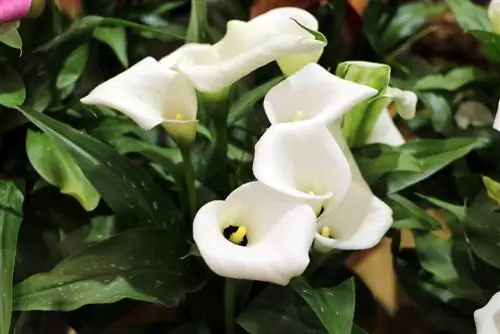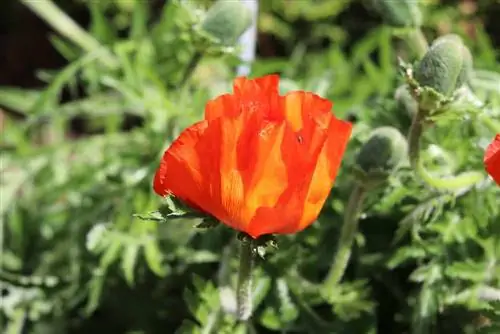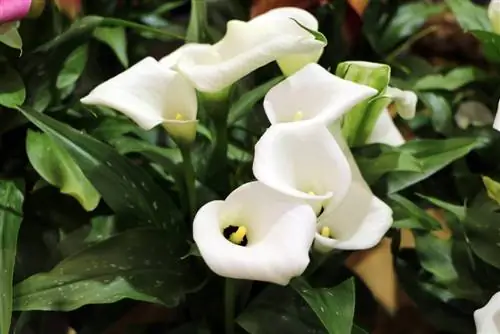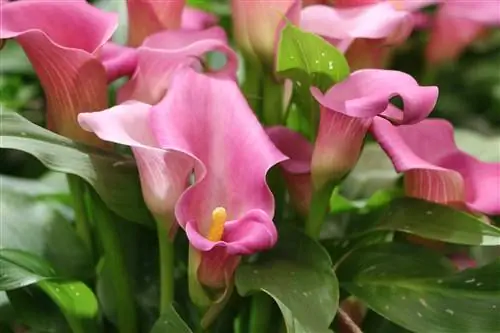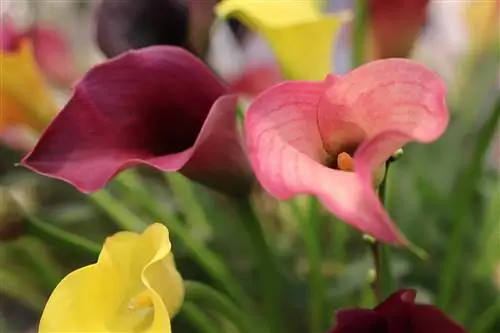- Author admin [email protected].
- Public 2023-12-17 03:39.
- Last modified 2025-06-01 06:48.
Are you wondering whether your calla lilies can tolerate frost? In fact, Zantedeschia do not limit themselves to a single blooming season when prudent gardeners take into account their level of winter hardiness. This applies equally to winter-flowering, evergreen indoor callas and summer-flowering, deciduous garden callas. Very few species of this elegant plant genus have learned to survive in winter conditions. The South African aroids still thrive as perennials. Find out here what the specific frost tolerance of the different calla species is. Find out more about how successful overwintering in a pot is.
Calla species are not hardy - with one exception
All calla species are native to Africa. There they chose different climate zones, which is why the different flowering times can be attributed. Summer-flowering Zantedeschias thrive in habitats with rainy summers, whereas winter-flowering calla species thrive in regions with humid winter climates. This results in care that is tailored to the species and takes into account adequate water and nutrient intake. When it comes to winter hardiness, however, all plants pull together.
In the central distribution areas of South Africa, average annual temperatures rarely fall below 20 degrees Celsius. Even in the northernmost habitats, such as Kenya, Zambia or Angola, the thermometer does not fall below 10 degrees Celsius during the coldest season. As a result, calla species and varieties are not hardy for indoor and outdoor use - with one exception.
The increased demand from enthusiastic calla fans for frost-hardy Zantedeschias did not go unnoticed by knowledgeable breeders. That's why the first winter-hardy calla hybrid for beds and containers is now ready for you. It is the white, summer-flowering variety 'Calla Crowsborough', which will certainly not remain the only frost-resistant variety for long.
Overwintering garden calla lilies - How to do it
Each calla sprouts from a rhizome or a tuber as a survival organ. Their growth is therefore comparable to well-known bulbous and bulbous flowers, such as tulips, cyclamen, lilies or gladioli. Since the flowers are reminiscent of lilies, the exotic plants are sometimes called calla lilies, although there is no botanical relationship between the two plants. Growing as a geophyte opens up two easy methods of overwintering for deciduous garden zantedeschiens. This is how you proceed professionally:
- From the end of August/beginning of September, gradually water less and no longer fertilize
- Dig out the tubers or rhizomes from the pot substrate or bed soil at the beginning of October
- Cut off the dried, dead herbaceous plant parts down to 5 cm
- Ideally brush off adhering soil and do not wash it off
- Let the tubers dry on a wire rack for 2 to 3 days
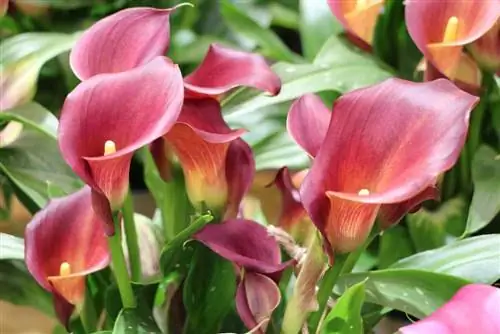
Various options are available for storage. Wrap the tubers in newspaper and place them on a wooden shelf. Alternatively, place the rhizomes in a box with dry sand or sawdust. You can also place calla lilies in a pot with dry peat or straw. The plants spend their winter rest in a frost-free, dark place with low humidity. Please ensure that temperatures do not rise above 15 degrees Celsius so that the rhizomes do not sprout prematurely.
Tip:
Zantedeschien secrete a poisonous plant sap. Skin contact may cause skin irritation, such as hives or rash. Please wear long-sleeved clothing and gloves when carrying out all planting and care work.
Information for ending hibernation
You are free to store calla rhizomes in dry, cool and dark conditions until the planting season begins in May. However, if you wake the exotic gems from hibernation early and grow the tubers, your effort will be rewarded with an earlier flowering period. This is how the plan works:
- Get the tubers out of the winter quarters at the beginning of March
- Fill pots or bowls with a mix of sand and peat in a ratio of 2:1
- Insert the root pieces 10 cm deep
- Press the substrate and just spray it with water
The Zantedeschias are happily sprouting again in the bright window seat at normal room temperatures. In proportion to growth, please increase the amount of watering water and add some liquid fertilizer every 14 days. At the beginning/mid of May, repot your calla into a pot with nutrient-rich potting soil or plant it in a sunny to semi-shady location in the bed.
Bringing frost-resistant calla lilies through the winter in the bed - this is how it works
If you have chosen the hardy calla variety 'Crowsborough', autumn tidying can be omitted from the care plan. Although the breeders of this Zantedeschia certify a frost hardiness of up to -20 degrees Celsius, for reasons of caution we recommend the following protective measures:
- Stop fertilizing and water less from July
- Before the onset of winter, cut the now dry plant back to 10 cm
- Spread a 10-15 cm thick layer of mulch made of leaves, brushwood or straw on the bed
- Alternatively cover with a breathable fleece
- Remove the mulch or fleece at the beginning/mid of March
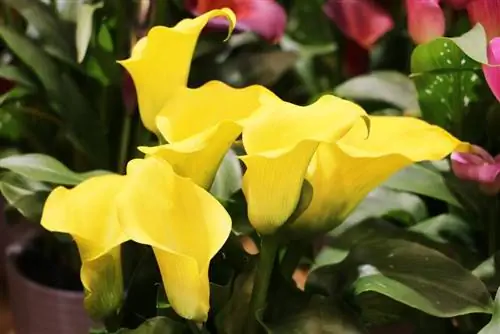
In late autumn, please wait until all shoots and leaves have completely retracted before pruning. This process ensures that the hardy calla can absorb and store all leftover nutrients. The plant can use this energy reserve next year to sprout on time and bloom again.
Winter hardy Zantedeschia in a pot outside
With its densely bushy, flower-rich growth, the hardy calla is ideal for cultivation as a perennial pot plant. Since the rhizomes are less protected in the pot than in the garden soil, appropriate protective measures are essential. With the following precautions, the perennial can overwinter on the balcony or terrace:
- Before the first frost, place the pot in front of a house wall protected from wind and rain or in a niche
- Push a block of wood between the stone floor and the pot to protect against the cold of the ground
- Cover the vessel with foil, fleece or jute
- Cut off the retracted shoots to a height of 10 cm
- Cover the substrate with autumn leaves, sawdust or straw
In the phase between late summer and the beginning of winter, please gradually reduce watering so that the rhizomes go dry into the cold season. This also includes that no more fertilizer will be administered from the end of July.
Please note that this winter protection is only successful for large containers. Please place pots with a diameter of less than 30 cm in frost-free winter quarters. If there is not enough space, place the pot in a wooden box with a thick layer of bark mulch on the bottom. Fill all cavities up to the edge of the pot with bark mulch and cover the substrate with leaves.
Overwintering indoor calla lilies in a pot - this is how it works
Winter is the flowering time for Calla aethiopica and Calla odorata, which thrive indoors. In late autumn, specialist retailers have young plants available that are about to start flowering or have already bloomed. This way you can preserve the exotic flowers during the cold season:
- Place in a bright window seat at 12 to 15 degrees until the flowering period begins
- Initially only water moderately with soft water and fertilize liquidly every 14 days
- Relocate the flowering calla to a sunny location with temperatures around 20 degrees Celsius
- Higher temperatures reduce the duration of the flowering period
During its winter flowering period, water your Zantedeschia generously so that the core of the root ball is constantly slightly moist. As soon as the first flowers develop, add liquid fertilizer for flowering plants to the irrigation water every 8 days.

If the flowering period is coming to an end from February/March, reduce the amount of irrigation water and stop supplying nutrients. Evergreen indoor calla with dry root balls spend their summer rest in a sunny, rain-protected spot in the garden. In early fall, the cycle begins again by clearing the plant, repotting it and resuming the water and nutrient supply.
Tip:
Calla species for cultivation as indoor or garden flowers should not be confused with dragonroot (Calla palustris), the only species within the genus Calla. This is native to the northern hemisphere and is completely hardy. The fact that dragonroot is often sold in stores as swamp calla is a constant source of confusion. There is only a distant botanical relationship with Zantedeschien.
Conclusion
Different growth and flowering times of South African calla species have no influence on the degree of their winter hardiness. As this guide shows, temperatures below 10 degrees Celsius are equally problematic for garden and indoor calla lilies. In order for the tropical flowering plants to thrive for several years, a cool, dry rest period is required after the flowering period. Summer-flowering, deciduous varieties also offer the option of overwintering the tubers without a pot in a frost-free, dark cellar. If you don't mind the little effort, push the root pieces from March onwards so that the elegant flowers develop earlier. The exception to the rule has so far been limited to a single variety. A Calla Crowsborough survives the winter in the bed under a thick layer of mulch. As a pot plant, the Zantedeschia receives a warming winter coat.

